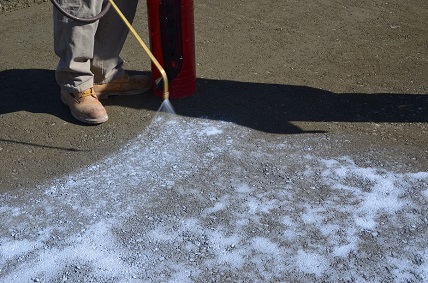Date: July 8, 2015
News - 6 Things to Consider When Sealing
Prolong and protect the life of your project by applying the best sealer for the job. There are plenty of sealer products on the market, each with its own specialty. With so many different concrete projects, you’ll need the right product to complete the application.
The right sealer will:
- Protect against wear
- Block unwanted dirt, oil, grease or other stain causing materials
- Improve the overall appearance
- Prevent water from permeating the surface and contributing to freeze-thaw damage
Desired Look
Depending upon the sheen level of the sealer, various appearances can be achieved. High-gloss to matte finishes are available using most acrylic sealers. If it is a colored or Decorative concrete project, solvent-based acrylics will make the pigments more vibrant. There is also the option of using a penetrating sealer so no particular sheen is visible. Also, consider the slip resistance needed if it is a high traffic or commercial application.
VOC Content
Check the volatile organic compound level or VOC of the product you plan on using if it is a solvent-based sealer to make sure it meets federal and local regulations. This information can be found on the Safety Data Sheet (SDS). Safety data sheets are available on our web site.
Drying Times
Consider how soon the project area needs to go into use. Acrylics can take as long as 12 hours to cure while polyurethanes and epoxies may take as long as 24 hours. These time frames are also depending upon several factors such as humidity and air temperature.
Breathability
If the project is outside, consider the breathability of an acrylic sealer as you will want the product to repel additional moisture from getting into the concrete yet still allow moisture vapor within the slab to be released. Epoxies are the best at repelling water but are considered impermeable so consider how much moisture may still be in the concrete.
Value of the Sealer
As with many items, you get what you pay for. Epoxies and urethanes tend to be a bit more expensive but they are known for their durability and performance over time. Check with the manufacturer to see what they claim as the life expectancy and what the warranty details are.
Compatibility
If you are applying a sealer over a surface with an existing overlay or coloring agents, check with the manufacturer to make sure the sealer is compatible. After all that hard work, no one wants to see their project start to bubble, blister or bleed before their very eyes. To take the guess work out of it and provide some piece of mind, simply purchase the sealer and overlay system by the same manufacturer.

Applying a sealer to your concrete project will result in many benefits, just keep these several points in mind when selecting the right sealer for the job.